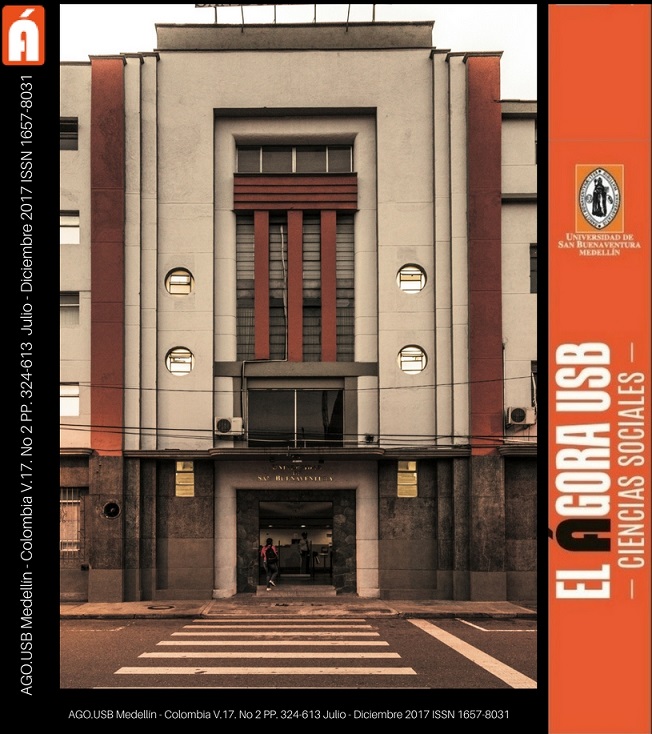View/Download
How to Cite
Carrillo González, L. (2017). Unarmed Everyday Lives: The Invisible Challenge of Territorial Transitions: An Open Window to Transitional Village Zones of Normalization in the Peace Process with FARC-EP. Ágora USB, 17(2), 462–471. https://doi.org/10.21500/16578031.3285
More Citation Formats
License terms
▼
The authors are also adhere to the creative commons license 4.0 (https://creativecommons.org/licenses/by-nc-nd/4.0/deed.es)
Attribution - NonCommercial - SinDerivar 4.0 International (CC BY - NC - ND 4.0)
Abstract
The model of transitional justice, which was discussed in Havana and its strong judicial emphasis, relegated the consideration of local social and community transition processes. Thus, these agreements omitted the complexity that the territorial dimension of the war has had and the everyday logic to which this has given rise that – apart from the hostilities and their humanitarian impacts – are expressed in various practices and social relations built among the insurgency, the State, and rural communities. The installation of Transitional Village Zones of Normalization as an instance and place in order to define the end of the armed conflict, has required a sign of the way how everyday lives, which were built within the framework of war, will be transformed. These villages then, pose, the first experience in the way how armed everyday lives have to be overcome, a task, which is defined as "invisible challenges" in this article (in the sense that they are not provided in the agreements), which for the communities, the State and the insurgency are the initial fee for the construction of a stable and lasting peace in the territories. In this article, an ethnographic overview of even incipient processes of transformation of armed everyday lives to unarmed everyday lives in the different ZVTN is presented
Keywords:
References
Carrillo, L. (2016) “¡Juntos, pero no revueltos! O de cómo se ha concertado un orden social en medio de la guerra: El caso de la región de El Pato. San Vicente del Caguán, Colombia, 1956-2016”. Tesis de Maestría. Colegio de Michoacán, México.
Espinosa, N. (2012) “Regiones insurrectas. Etnografía de la identidad política y la construcción territorial de los llanos del Yarí, Colombia”. Boletín de Antropología No. ´XX
OACP (Oficina del Alto Comisionado de Paz) 2016. “Punto tres del Acuerdo Final”. Disponible en: http://www.altocomisionadoparalapaz.gov.co/procesos-y-conversaciones/Documentos%20compartidos/24-11-2016NuevoAcuerdoFinal.pdf Fecha de Consulta: Mayo 1 de 2017.
ONU. (agosto de 2016). Informes del MMV. Obtenido de colombia.unmissions: https://colombia.unmissions.org/informes-del-mmv
Rangel Suarez, A. (22 de febrero de 2016). "Vamos hacia muchos 'Caguanes' a lo largo y ancho del país". Obtenido de Congreso Visible: http://congresovisible.org/agora/post/vamos-hacia-muchos-caguanes-a-lo-largo-y-ancho-del-pais/8092/
Semana (Revista). 2016. “Arremetida del procurador contra zonas de concentración de las FARC” Tomado de: http://www.semana.com/nacion/articulo/alejandro-ordonez-dice-que-no-puede-haber-zonas-de-ubicacion-sin-la-firma-de-acuerdos-de-paz/462986 Fecha de Consulta: Mayo 1 de 2017.
Espinosa, N. (2012) “Regiones insurrectas. Etnografía de la identidad política y la construcción territorial de los llanos del Yarí, Colombia”. Boletín de Antropología No. ´XX
OACP (Oficina del Alto Comisionado de Paz) 2016. “Punto tres del Acuerdo Final”. Disponible en: http://www.altocomisionadoparalapaz.gov.co/procesos-y-conversaciones/Documentos%20compartidos/24-11-2016NuevoAcuerdoFinal.pdf Fecha de Consulta: Mayo 1 de 2017.
ONU. (agosto de 2016). Informes del MMV. Obtenido de colombia.unmissions: https://colombia.unmissions.org/informes-del-mmv
Rangel Suarez, A. (22 de febrero de 2016). "Vamos hacia muchos 'Caguanes' a lo largo y ancho del país". Obtenido de Congreso Visible: http://congresovisible.org/agora/post/vamos-hacia-muchos-caguanes-a-lo-largo-y-ancho-del-pais/8092/
Semana (Revista). 2016. “Arremetida del procurador contra zonas de concentración de las FARC” Tomado de: http://www.semana.com/nacion/articulo/alejandro-ordonez-dice-que-no-puede-haber-zonas-de-ubicacion-sin-la-firma-de-acuerdos-de-paz/462986 Fecha de Consulta: Mayo 1 de 2017.
Downloads
Download data is not yet available.




















